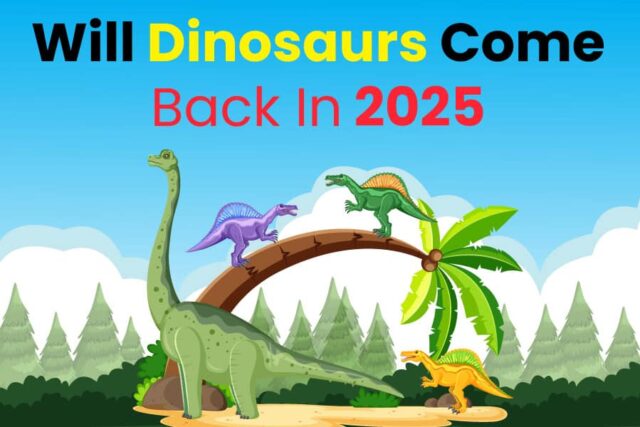Dinosaurs were crushed many years ago. Now, questions like “Will dinosaurs come back in 2025?” This question is gradually gaining traction.
Over the millennia, thousands of animals have gone extinct. Some became extinct due to human intervention, while others due to changes in the climate.
Scientists have made clear their intentions to bring back some of these animals. The question is, will dinosaurs be among the creatures they’ll get back? Or, what other ways will dinosaurs come back to earth?
Here, I’ll explain all you need to know about dinosaurs coming back to earth in 2025 and the animals that scientists want to bring back from extinction. Read for more details.
Will Dinosaurs Come Back In 2025?
Unfortunately, dinosaurs are extinct and won’t come back. Not in 2025. All we have of them is their remains, nothing more.
Scientists are working on returning several animals from extinction. Unfortunately, the dinosaur isn’t one of them. Improvements in biotechnology have made it possible to bring back some of the animals that have gone extinct.
Unfortunately, there don’t seem to be plans to bring back dinosaurs. They are extinct, so they should remain so.
Have Scientists Made Attempts To Bring Back Dinosaurs in 2025?
Scientists still believe that they can bring back dinosaurs. Dr. Alan Grant, Jurassic Park’s scientist, believed Dr. Jack Horner was working on bringing back dinosaurs from extinction.
Dr. Alan claimed Dr. Jack Horner was working on creating the chickenosaurus. He claimed the DNA he was working on was rooted in chickens, the dinosaurs’ ancestors.
Dr. Alan Grant consulted for Jurassic Park, and Dr. Jack’s work heavily inspired him. He believed the DNA of dinosaurs had all the answers needed to bring them back shortly. Unfortunately, recent studies have shown how impossible it is to use the DNA of dinosaurs for the said experiment.
Dr. Jack Horner has been seeking means to bring back the dinosaurs using their DNA. He has been trying to extract the dinosaur’s DNA but has failed.
Why has Dr. Jack Horner yet to be successful in his quest to extract the DNA of dinosaurs? According to the highly-respected scientist, he claimed the reason for his inability to extract the DNA of dinosaurs successfully was:
Dinosaurs have quite a large DNA
Another reason is the instability of the DNA.
Whenever he manages to extract the DNA, they all crumble. This experience made me work with the DNA samples extracted. You need the DNA to remain stable to study and use.
The massiveness and instability of the DNA of dinosaurs isn’t deterring Dr. Jack Horner. He’s a man on a mission who wants to create something from the few DNA samples he has acquired.
In the last couple of years, he has been trying to mesh different DNA samples together. He wants to create a “chickenosaurus,” as he calls it.
In his words, the wings and hands aren’t a problem. The major challenge he would encounter is the tail. The chickenosaurus will have something like an alligator tail.
A Handy Tip: Did you know Dr. Jackson Horner wanted velociraptors used in the Jurassic Park movie to have features? He wanted the dinosaurs to be multi-colored, as he considers all birds as dinosaurs.
You didn’t find technicolored-feathered velociraptors in the Jurassic Park franchise because the producers didn’t fancy the idea. They claimed a dinosaur or velociraptor with multiple colors wouldn’t scare anyone. Instead, people will be admiring their beautiful colors.
Dr. Jackson Horner still believes dinosaurs can return. He claims the chances of this happening relate to the success of his “dino-chicken” experiment. That is a chicken with dinosaur teeth and an alligator tail.
Dr. Jackson Horner believes that after the dino chicken’s emergence, the second version would be closer to the velociraptor. From there, he can deliver a real dinosaur.
By now, those speculating about dinosaurs’ return believed Dr. Jackson would have created a dinosaur in the real world. It’s over a decade since his first interview, and we haven’t seen any of the results Dr. Jackson promised.
There are no chickenosaurus (turning chickens into dinosaurs) or a real dinosaur, for that matter. Jurassic Park one has aired, part two has also hit the big screen, and others are coming. Yet, no real dinosaur has emerged from the numerous experiments. There are also no signs that we will see any dinosaurs soon.
Will Dinosaurs Re-Evolve In The Future?
Dinosaurs died 66 million years ago. All of them were wiped off by asteroids that hit the planet. The only pieces of dinosaurs left on the earth are mummified remains and birds (called living dinosaurs). Scientists claim birds evolved from dinosaurs.
So, will dinosaurs evolve if temperature and climate return to how they were during the Cretaceous? Note the Cretaceous period lasted from 145 to 66 million years ago.
This cretaceous period occurred after the Jurassic period and before the Paleogene – the first period before the Cenozoic era, which is our era.
As Stephen Jay Gould, the great though deceased American Paleontologist, puts it, what would happen if we rewound life to some years ago and press play? When it comes to the present day, would the world be different? Of course, things would be different.
If there is one thing extinction has taught us, it’s that any creature that becomes extinct never returns. A good example is the trilobites.
Is the climate in the ocean today different from how it was when the trilobites flourished? Have the trilobites returned because the climatic condition is conducive for them? No, they haven’t.
The term “convergence” remains a powerful word in evolution, as it explains that species evolve when they face similar climatic and environmental factors. An example is the mammal “bat.” They are mammals, yet they grow wings and can fly.
Birds that scientists claim emerge from dinosaurs grew wings. They have to adapt to the present conditions in which they find themselves.
To sum it up, even if the climatic and environmental factors become conducive for dinosaurs to thrive, they’ll never re-evolve. They are dead and have gone extinct.
Instead, we may find animals with new features as a means to adapt to climatic and environmental changes. Unfortunately, dinosaurs won’t return, not even in 2025.
Are Dinosaurs Among Animals Scientists Are Planning To Bring Back?
Dr. Jack Horner tried to bring back dinosaurs. He believes that dinosaurs can come back via DNA. Unfortunately, all efforts to make this work have failed. Dinosaurs have quite a large DNA.
Besides the massiveness of the DNA, another issue that has made scientists’ plan to return dinosaurs impossible is the stability of the DNA. The dinosaur’s DNA isn’t stable.
Scientists believe they can bring back several animals no longer with us. Here is a list of these animals.
1: Cuban macaw:
The Cuban macaw or Cuba red macaw is native to Cuba. These vibrant and multi-color birds became extinct in 1864.
What caused the extinction of the Cuban macaw?
These creations went into extinction for numerous reasons. These include deforestation, hunting, and capture by humans. People kept the Cuban macaws as birds, especially the young ones.
The Cuban macaw lived in the damp forest of west and central Cuba. It lived in small groups or pairs, and that’s the only information regarding its social behavior.
The last confirmed Cuban macaw on planet earth was shot near Zapata swamp in 1864. So, we have destroyed the Cuban macaw population.
A Handy Tip: There were rumors that aviculturists have bred birds with similar appearances to Cuban macaw. However, those birds were slightly bigger than the macaw but had identical genes.
2: Woolly Mammoth:
Are humans responsible for the extinction of woolly mammoths? That is a question for another day. Meanwhile, scientists are heavily contesting this claim. Many believed humans didn’t have a hand in the extinction of mammoths.
The woolly mammoths lived from the Middle Pleistocene until their extinction occurred in the Holocene Epoch.
Are mammoths bigger than elephants? According to scientists, most mammoths were as giant as modern-day elephants. The North American imperial mammoth attained a shoulder height of 14 feet.
What killed mammoths if humans weren’t responsible? Some reports claim mammoths died due to the melting iceberg. The melting iceberg resulted in wet vegetation (mammoths’ food), leading to their deaths.
When was the last woolly mammoth on earth?
The report shows that the last mammoth survived until 1650 B.C. That was over 1000 years ago, after the construction of the Pyramids at Giza.
So, rain and snow killed the mammoths, not humans. They made it extremely difficult for the animals to find food to sustain their lives.
Humans also hunted mammoths because of their meat and skin. However, the unavailability of food caused by extreme weather conditions was the primary contributor to their extinction.
A Handy Tip: Scientists can still access the well-preserved DNA of mammoths. Their cases have been well-preserved for an extended period.
3: Woolly Rhinoceros:
The woolly rhinoceros, also called “woolly rhino,” is an extinct species that occupied northern Eurasia during the Pleistocene Epoch.
How long can woolly rhinoceros live? The report shows they can live for around 40 years like their modern counterparts.
Furthermore, the woolly rhino ate grasses and sedges. They are also incredible runners.
These animals can reach a speed of 30 miles per hour. They are that fast.
What is responsible for the extinction of woolly rhinoceros?
The genetic analysis of 14 remaining woolly rhinos showed that a warm climate is responsible for their demise, not hunting.
That is not to say they weren’t hunted. Humans and large cats hunted the woolly rhinoceros. Early humans even made spears out of their horns.
A Handy Tip: The woolly rhinoceros is different from the modern rhinos. While the woolly rhinos have long horns with prominent edges, the Sumatran rhinos have small and blunt horns.
The woolly rhinoceros was well-prepared for the cold during the ice age. It had stocky legs and a woolly coat.
Scientists want to re-introduce the woolly rhinoceros back to the planet. There are claims that human hunting played a significant role in their extinction, despite a claim that a warmer climate did.
Scientists want to compensate for the atrocities the early human hunters committed on the woolly rhinoceros by re-introducing them back to the planet. It’s a good idea anyway!
4: The Moa:
What caused the extinction of the moa? The moa is a flightless bird that weighs over 500 pounds. Their weight alone showed why they couldn’t fly.
Over-hunting by humans is one of the significant factors that led to the extinction of the moa. They were heavily hunted by the Maori around 1400.
Where did the moa originate from? The moa were predominantly seen in New Zealand.
How tall is the moa? This flightless bird can reach a height of 12 feet. So, they are pretty tall.
A Handy Tip: The moa is no longer there but has left a distant relative, the South American tinamous. Scientists believe the tinamous holds some of the genes of the moa.
Despite being a relative, the South American tinamous are a direct opposite of the moa. The tinamous can fly, while the moa can’t.
5: The Elephant Bird:
This flightless bird is another avian special many would like to see return to the planet. Unfortunately, the elephant birds died around the 17th century.
The fascinating fact about these birds is that they only occupied the island of Madagascar.
But then, what is responsible for the extinction of such a beautiful creature?
Human activities were responsible for the death and extinction of the elephant birds. The arrival of humans on the island of Madagascar drove the creatures away.
Both in terms of hunting and competition for space, humans destroyed the habitat of elephant birds as they cleared fields for shelter and agriculture.
Scientists believe they can bring back the elephant birds. However, whether it will happen in this generation or the next remains to be seen.
But the truth is, we are responsible for the extinction of the elephant birds, and re-introducing them back to their natural habitat won’t be a bad idea.
6: The Freshwater Dolphin:
Was there ever a species of dolphin that lived in freshwater? Yes, there was. The dolphins live in China’s Yangtze River, and they are called Baiji.
These dolphins were declared extinct a few decades ago. But there is hope, as scientists claim they spotted one in the river last year.
If that is the case, all hands must be on deck to increase their population. Scientists must initiate a conservation plan as quickly as possible to improve the population of the freshwater dolphin before we lose them again.
A Handy Tip: The last verified sighting of the freshwater dolphin was in 2002. However, by 2006, it was declared extinct.
The claim that a freshwater dolphin was spotted in the Yangtze River in China has not been confirmed. But let’s hope it is true, as no animal deserves to go extinct.
7: Irish Elk:
The Irish elk, aka giant deer, is no more. The animal was declared extinct long ago.
What is responsible for their extinction?
Hunting is part of the reason the Irish elk became extinct. However, scientists claim a warmer climate significantly contributed to their extinction.
The warm climate affected the food and grazing land of the elk. Food and land to graze became a problem.
The most recent remains of the giant Irish deer have been carbon-dated to about 77 years ago in Siberia. However, scientists believe the fallow or red deer are a distant relative of the massive Irish elk and may hold some of their genes.
8: The Steller’s Sea Crow:
The two remaining species of sea crows are the dugong and manatee. The steller’s sea crow is related to both.
These creatures were abundant in the Northern Pacific but were wiped off within 27 years.
The good news is that the dugongs could have some of the steller’s genes and may help scientists bring back the creature.
But how did the steller’s sea crow become extinct?
Humans are responsible for the extinction of the steller’s sea crow. People hunted them over seven times more than their sustainability rate.
Conclusion
Will dinosaurs come back in 2025? Scientists are working hard to bring back dinosaurs but have yet to succeed. Dr. Jack Horner has been leading the research. He claimed he wanted to create a chickenosaurus, which hasn’t materialized.
Dinosaurs won’t come back in 2025 or the near future, as scientists have learned the truth. Dinosaurs have a very huge DNA. Additionally, the DNA is unstable.
Scientists haven’t given up hope in their question to bring back several animals that have gone into extinction. They believe they can restore most of them by accessing their DNA samples.














